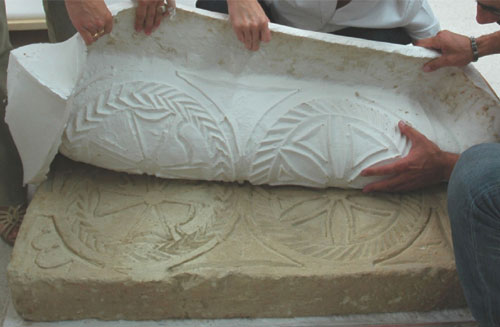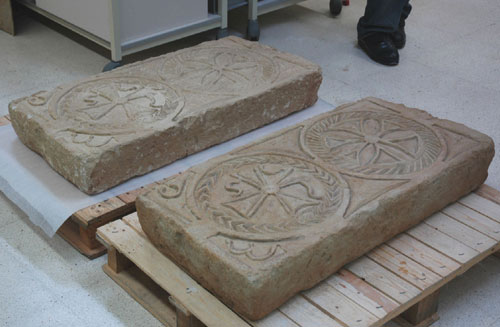MARQ Alicante utiliza cookies propias y de terceros para mejorar su experiencia de navegación
y realizar tareas de analítica. Si continúa navegando, entendemos que acepta nuestra política de calidad y de cookies.
MARQ Alicante utiliza cookies propias y de terceros para mejorar su experiencia de navegación
y realizar tareas de analítica. Si continúa navegando, entendemos que acepta nuestra política de calidad y de cookies.
NEWS MARQ - 28 de Septiembre de 2009
MARQ CREATES A REPLICA OF ITS VISIGOTH CARVING
(Albufereta, Alicante)
Marq has made a close copy of one of the most emblematic early Christian objects found in the Alicante province. The replica will be placed in the seat of the Bishopric of Orihuela-Alicante in Alicante.
The work required to create the replica was carried out in MARQ’s Conservation Laboratory by the restorers Silvia Roca and Elena Santamarina, the conservation technician Antonio Chumillas and with the help of Ana Rodríguez, on a conservation placement.
The work consisted of creating a liquid silicon mould into which a prepared mixture of polyester resin and marble powder was poured. The result is a practically identical model to the original.


The original relief:
Sandstone
97 x 46 x 12 and 66 x 50 x 13 cm
Visigoth
7th century AD
A sandstone relief decorated with Christian symbols was found in the right hand bank of a gulley in the Albufereta marshland. Albufereta is located close to the sea, three km to the north of the historic centre of Alicante, and close to the site of el Tossal de Manises, where the Roman city of Lucentum was established.
The stone relief is rectangular in shape and is decorated with two tangent circles. The exterior edge of the slab and the circles are marked by an incised line. The first circle is composed of (from the outside to the centre) a smooth circumference, oblique carved lines (rope-like) and in the centre a six pointed star or rosette with various carved fusiform shapes with bevelled edges. The second, again from outside in, is composed of a flat circumference, a circular motif in the form of a laurel or palm crown which encloses a cross with triangular arms and concave ends. Either side of the upper arm are the letters “C” and “S”. In the corners between this circle and the edge of the stone slab are the Greek letters “alpha” (badly drawn) and “omega”.
The original relief is on display in the Roman and Late Antiquity Gallery in MARQ.
Circumstances surrounding its discovery
This relief, together with another similar relief (although incomplete) were discovered in the early decades of the 20th century. They were found as part of the cover of a tomb dating to the early medieval period (8th century). However, they were originally decorative architectural features (a frieze or perhaps a chancel) which would have decorated a Visigoth Christian basilica. In the 1920s, a stone crypt was also found in the same location, which contained a stone sarcophagus. This may also have been part of the basilica where the relief came from.
Historical considerations:
Plaques or slabs with this type of decoration have been found as part of friezes, chancels and altar tables. Examples of a similar decorative style have been recorded in various urban sites in the South East of the Iberian peninsula listed in the Treaty of Theodemir (a pact between the Visigoth nobleman and the victorious invading Muslim troops who had conquered the Christian kingdom) including el Tolmo de Minateda (Hellín, Albacete), Cerro de la Almagra (Mula, Murcia) and Begastri (Cehegín, Murcia). This evidence could indicate the possible existence of one or various court or official workshops which could have supplied the ornamental architectonic features to the main towns under the authority of the Visigoth capital of Toledo.
The relief, the crypt mentioned above, and the large number of late antiquity burials found in the same area indicate that there was a settlement site with an important Christian cult site in the Albufereta area of Alicante which dates to the Visigoth period. It may also be evidence that the town of Laqant, mentioned in the Treaty of Theodemir, could have been founded here.
The symbols:
There are a number of important decorative features on the relief, the meanings of which have been interpreted. The first symbol is a Greek cross which dates to the Visigoth period. The cross (with four arms of equal length that are bisected perpendicularly) is the earliest and most important Christian symbol. It is the main icon of the Christian faith, as Jesus Christ and numerous 1st century martyrs were crucified on the cross. It also symbolises the relationship between heaven and earth, as well as the four cardinal points constituting the centre of balance between the active and the passive. “Cross pattées” sometimes have, like this example, “alpha” and “omega” symbols hanging from the horizontal arms. These are apocalyptic letters (“Christ is the Beginning and the End”) part of the Chi Rho (the symbolic symbols of Christ) and have Roman-Byzantium origins.
Another decorative feature are the rosettes which often result from the multiplication of sectant circles in screens from Visigoth chancels. These features are always inscribed in circles and are geometric motifs which have a cosmic symbology (“Christ-Sun”) and are associated with the ideas of balance, harmony and justice.
Manuel Olcina Domenech
omega replica watches https://www.eredyshop.me
Localización | Horarios | Tarifas | Mapa web | Política de privacidad
SEDE ELECTRÓNICA | info@marqalicante.com | Tlf.: 965 149 000

Página diseñada y realizada por
CREHAZ
COMUNICACIÓN Y TECNOLOGÍ